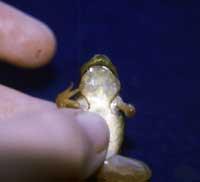The decline of amphibian populations worldwide
In order to know the causes of these problems, the scientific community has carried out various research.
It is clear that the amphibian population has suffered a spectacular decline. Many species are now considered missing and in many other species, such as limb deformation and hermaphroditism, have seen it appear more frequently than normal.

The causes of the appearance of deformations in the extremities have not yet been clarified. Although some scientists claim that this is a natural phenomenon, many believe that it is a direct consequence of pollution. In any case, the problem is quite serious. In fact, deformations can be one of the causes of the decrease in amphibian populations, since deformed amphibians have a great disadvantage over healthy ones. However, amphibians are not the only living beings that are in contact with pollution and they show the highest rates of deformation. Why do amphibian deformations occur?
Natural processes
As has been said, behind these deformations there are many possible factors and scientists believe that you cannot blame one single factor. For some they are the fruit of natural processes, as is the case of the predation suffered by amphibians in the time of the tadpole: the tadpoles, when they begin to produce metamorphosis, suffer the attacks of other frogs and fish and often eat them the developing extremities.
Trapped in the early stages of metamorphosis, the tadpoles have the capacity to form a new limb, but in the late phases they completely lose this capacity and, as a result of the aggressions, deformed members appear.
In addition, there are parasitic trematodes that produce deformed legs. Trematodes are worms of a few millimeters. In a phase of their life cycle they live on the hip of frogs and can produce deformations in the legs.
The two episodes mentioned are natural and deformed frogs have always appeared in wetlands. According to the scientists who promote the theory of natural processes, until recently few cases of amphibians have been made and no comprehensive study of them has been carried out.
When scientists realize the importance of amphibians, studies are conducted and they begin to see deformed amphibians that were previously hidden. They were already there, but no one was in charge of confirming that.
However, for many scientists this explanation is only an excuse to cover the problem. Despite recognizing that some cases of deformity are natural, it seems evident that there are many more cases than normal. In addition, many studies have shown that deformations are directly related to high concentrations of pesticides.
Serious effects of pesticides

Most of the pesticides used today are biodegradable and are said to practically not harm the environment. However, many times it is not known which are all components of pesticides, as some of them are secret elements of the brand and therefore trade secret. Therefore, it is not possible to know with certainty what substances they are and how they can affect the environment.
In addition, substances derived from pesticides must be taken into account. In the process of pesticide biodegradation, molecules undergo numerous chemical transformations and, according to some scientists, the molecules generated during this period can be more dangerous than the pesticide itself.
And what is the relationship between pesticides and deformed amphibians? Many of these substances act on the endocrine system that produces and controls hormones. Its appearance is similar to that of hormones, but it is not able to fulfill its function.
Consequently, once the organism has been deceived and introduced, the deformation of the limbs is only a problem. The problem may be more serious than expected, as amphibians spend almost their entire life in water and are therefore in continuous contact with chemicals dissolved in water.
In addition, hermaphroditism has been observed in many amphibians: male and female animals develop both types of sex organs, which is no advantage for amphibians.
There is therefore a great debate in the scientific community in explaining the causes of amphibian decay and all the problems they have. For many, you cannot blame everything on the only factor. This situation seems due to the combination of all the factors mentioned and others still unknown.
Published in the supplement Estación de Gara.
Buletina
Bidali zure helbide elektronikoa eta jaso asteroko buletina zure sarrera-ontzian











